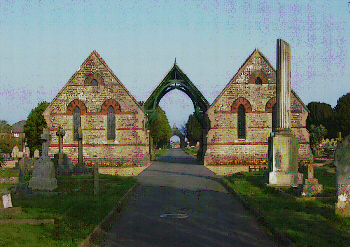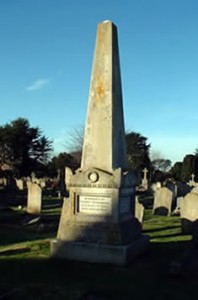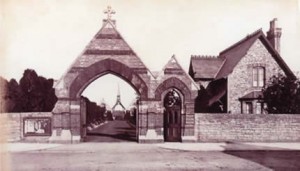
FORC was set up in 2001 by the newly-elected County Councillor for the area, along with a number
of residents, all of whom were concerned at the state of the County Council-owned Cemetery.
Initially laid out in 1840, and later extended to an area covering 12 acres with over 20,000 graves,
it was in a very run down and neglected state. Gravestones had been vandalised, and from time to time it even provided temporary accommodation for 1 or 2 homeless people!
Working parties were established, usually meeting fortnightly, to clear many of the graves of ivy,
brambles and trees, and remove the undergrowth from the bushes around the perimeter.
Ryde Cemetery contains more than 20,000 graves and vaults. Many are the last resting place of well-known Ryde families from the 19th century to the present time.
 The prosperity of many of the local trades-people and businessmen can be seen from the considerable number of imposing and elaborate stone memorials that exist. Some of the wealthiest families purchased sufficient space for the construction of vaults where several members of the family could be buried together.
The prosperity of many of the local trades-people and businessmen can be seen from the considerable number of imposing and elaborate stone memorials that exist. Some of the wealthiest families purchased sufficient space for the construction of vaults where several members of the family could be buried together.
The oldest graves are in the southeast corner of the Cemetery on the land given by George Player in 1840. This part of the Cemetery is referred to as the
Old Parish Cemetery or OPC.
Some of the earliest graves identified so far by Ryde Social Heritage Group in the OPC include those of Charles SAUNDERS, Mary-Ann OSMOND, Lawrence BROWN, Thomas MURRAY, Harriet CHESTER, Henry GROVES, Sarah PRICE, John WAGNER, and Emma COOPER.
Also in this part of the Cemetery is an obelisk to the memory of Thomas Dashwood, a timber merchant and master builder. There are many monuments existing to his skill as a builder. He built Brigstocke Terrace, the Market House and Town Hall, St Thomas’ and Holy Trinity Churches. He was one of the wealthiest men in the town when he died in 1861.
The Old Parish Cemetery soon began to fill up and by the late 1850s it became clear that more land was requried. An extension was made to the north and west in 1860/1862. The central driveway was installed at this time, the two central chapels and the Cemetery Lodge were also built around that time.
This expansion of the cemetery is now known as The Old Cemetery.
1862 Cemetery Regulations
1866 Petition by ratepayers of Ryde, not to level unattended graves
1877 Cemetery Consecration
 This picture shows the cemetery gates, the Lodge, the central driveway and the two chapels with the covered porch and bell tower.
This picture shows the cemetery gates, the Lodge, the central driveway and the two chapels with the covered porch and bell tower.
This article in the IW Times on 5 February 1863 describes the cemetery:
This “heaven canopied chamber of the dead,” has been taken possession of by the representatives of all those classes into which the Christian world, even after the great leveller death has done his work upon them, remains divided. The consecrated portion of the ground has already had many sleepers of the long sleep, laid beneath its sods. On Monday last that part of the inclosure set apart for the use of our Romish fellow Christians, was inaugurated by the interment of the “oldest inhabitant,” and on Tuesday, the non-conformist body took possession of their allotted part, by placing within the earth’s peaceful bosom an infant of a few years old. The contrast between ninety-seven and three years was wide indeed, and yet, when compared with the duration of that future world into which mysterious region each has entered, the ninety years, seem but “as a watch in the night.” These cheery planted cemeteries which have superseded the gloomy church yards of the past, are beautifully indicative of a happy future. A Christian cemetery may with truth be called “a garden of hope.”
A further extension to the west in 1881/1882 took the boundary of the Cemetery to Pellhurst Road it has not been extended further since that date and it is now full except for a very few spaces.
This expansion of the cemetery is now known as The New Cemetery.
We would like to thank Ryde Social Heritage Group for the detailed information about the Cemetery’s history.